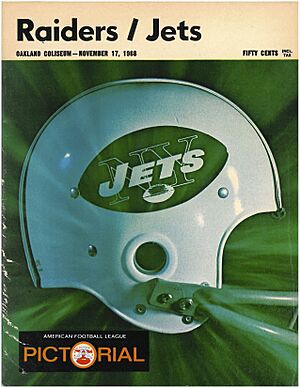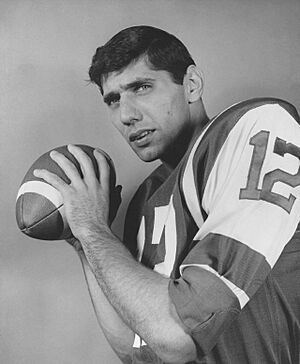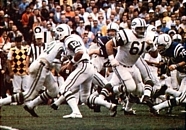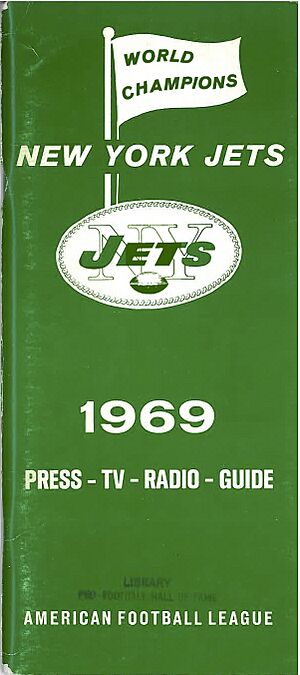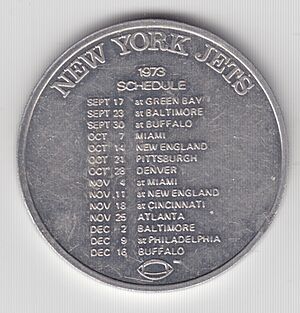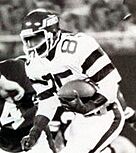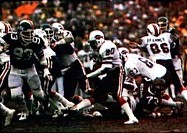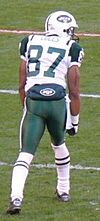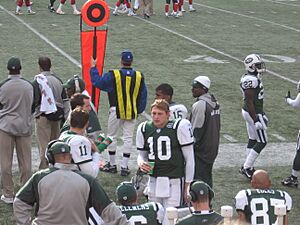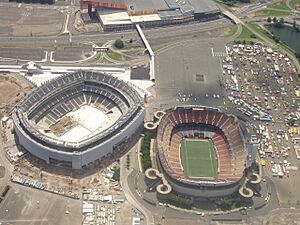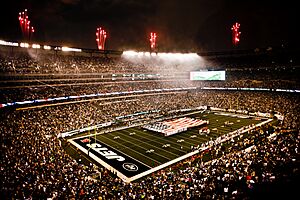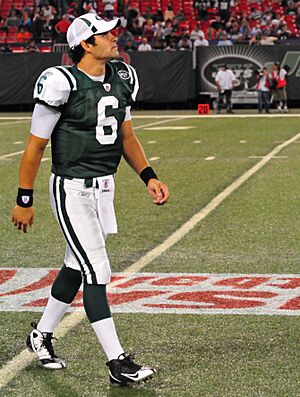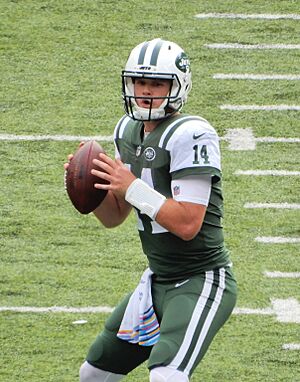History of the New York Jets facts for kids
The New York Jets are an American football team with a long and exciting history! They started in 1959 as the "Titans of New York" and were one of the first teams in the American Football League (AFL). They began playing games in 1960. In their early years, the team didn't win much.
In 1964, the team changed its name to the New York Jets and moved into a new stadium called Shea Stadium. A big moment came in 1965 when the Jets signed a famous quarterback named Joe Namath. The team slowly got better, and in 1967, they had their first winning season. In 1968, they won their only AFL championship. This win meant they got to play in Super Bowl III against the Baltimore Colts, who were the champions of the National Football League (NFL). The Jets surprised everyone by winning the Super Bowl! This victory helped show that the AFL was just as good as the NFL, and soon the two leagues merged.
After the merger, the Jets had some tough years, and Joe Namath often dealt with injuries. In 1981, the team made it to the playoffs again. They even reached the AFC Championship Game in 1982 but lost to the Miami Dolphins. From 1984 onwards, the Jets started playing their home games in New Jersey at Giants Stadium. The team had a great start in 1986, winning 10 of their first 11 games, but then faced more injuries and lost in the playoffs.
The Jets struggled for a while, even having a very tough 1–15 season in 1996. But things turned around in 1997 when they hired Bill Parcells, a coach who had already won two Super Bowls. Parcells led the team to a fantastic 12–4 record in 1998, and they reached the AFC Championship Game again, though they lost to the Denver Broncos. The 2000s were a good decade for the Jets, as they made the playoffs five times. In 2009 and 2010, they made it to the AFC Championship Game two years in a row, but couldn't quite reach the Super Bowl. In 2010, the Jets moved into their new home, MetLife Stadium, which they share with the Giants.
Contents
How the Jets Started (1959–1964)
Forming the Team
In 1959, two oil businessmen, Lamar Hunt and Bud Adams, wanted to start an NFL team. But the NFL owners didn't want to expand. So, Hunt and Adams decided to create a brand new football league! They found other wealthy people who wanted to own teams.
William Shea, a lawyer from New York City, was trying to start a new baseball league. He suggested Harry Wismer, a former sportscaster, as a possible owner for a New York team in the new football league. Wismer agreed, and on August 14, 1959, the new league was announced. Eight days later, it was named the American Football League (AFL). Wismer's New York team was called the "Titans of New York."
On November 24, 1959, the AFL held its first player draft. The Titans picked quarterback George Izo as their first player. The league also decided to get one TV contract for all the teams, which was a new idea at the time. The Titans hired Sammy Baugh, a famous former football star, as their first head coach.
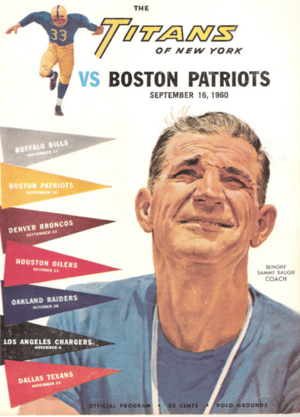
Playing at the Polo Grounds
The Titans needed a place to play, and they ended up at the old Polo Grounds stadium in Manhattan. This stadium had been empty since the New York Giants baseball team left in 1957.
The Titans played their first preseason game on August 6, 1960, and lost. Their first regular season game was on September 11, 1960, against the Buffalo Bills. It rained heavily, and the field was very muddy, but the Titans won 27–3! However, the team had a tough season, finishing with a 7–7 record. They also had financial problems, and some people joked that the fans had "disguised themselves as empty seats" because so few people came to the games.
New Owners and a New Name
The Titans continued to struggle with money and winning games. In 1961, some players' paychecks even bounced! The team hoped to move to a new stadium in Queens, called Shea Stadium, but it wasn't ready yet.
By November 1962, owner Harry Wismer told the AFL commissioner that he couldn't afford to run the team anymore. The league took over, and soon a group of five businessmen bought the team for $1 million.
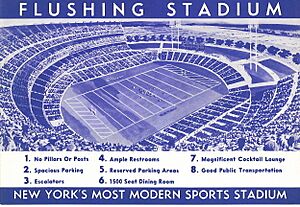
On April 15, 1963, the new owners hired Weeb Ewbank as head coach and general manager. Ewbank was a very respected coach who had won two NFL championships with the Baltimore Colts. The team also announced a new name: the New York Jets! They chose the name "Jets" because the new stadium was near New York's two main airports, symbolizing speed and modern times. Their new colors were green and white, with green representing hope and high spirits.
The Jets still had some challenges, like not being able to move into Shea Stadium until 1964. But they started to get better on the field. In their last game at the Polo Grounds in December 1963, they lost to the Bills.
On September 12, 1964, the Jets played their first home game at Shea Stadium, winning 30–6 against the Denver Broncos. Over 52,000 fans came, setting a new attendance record for the AFL. The Jets had a good home record that year but lost all their road games, finishing 5–8–1.
As the 1964 season ended, everyone was talking about Joe Namath, a star quarterback from the University of Alabama. The Jets managed to get the first pick in the AFL draft and signed Namath to a huge contract for the time.
The "Broadway Joe" Era (1965–1976)
The Road to Super Bowl III
Joe Namath signed with the Jets for an amazing $427,000 over three years, plus a convertible car! The Jets knew Namath had knee problems, and he had surgery soon after signing. The media paid a lot of attention to Namath, who became known for his flashy lifestyle and was nicknamed "Broadway Joe."
Namath didn't start the first game of the 1965 season, but he quickly became the starting quarterback. He was named AFL Rookie of the Year. The Jets finished 5–8–1 again. In 1966, the Jets improved to a 6–6–2 record. That year, the NFL and AFL announced they would merge in 1970, and a championship game (the Super Bowl) would be played between the two league champions each season until then.
In 1967, Namath threw for a record 4,007 yards, and the Jets had their first winning record, 8–5–1. In 1968, the Jets started strong, winning many games. They had a famous game against the Oakland Raiders, known as the "Heidi Game." The Jets were leading late in the game, but NBC switched to a TV movie of Heidi before the game ended. The Raiders scored two quick touchdowns to win, but many viewers missed it! Despite that loss, the Jets finished 11–3 and then beat the Raiders in the AFL Championship game, 27–23, to earn a spot in the Super Bowl.
Super Bowl III
On January 12, 1969, the Jets faced the Baltimore Colts in Super Bowl III. The Colts were a powerhouse team, with a 13–1 record, and most experts thought they would easily win. Many predicted a huge victory for the Colts.
But Joe Namath was confident. He famously guaranteed a Jets victory, saying, "We're going to win Sunday, I'll guarantee you."
The game was a tough defensive battle. At halftime, the Jets led 7–0 with a touchdown run by Matt Snell. The Jets' defense played incredibly well, stopping the Colts again and again. Jim Turner added two field goals to make it 13–0. The Colts finally scored a touchdown late in the game, but it wasn't enough. The Jets won 16–7, in one of the biggest upsets in football history! This victory proved that the AFL was a strong league.
After the Super Bowl
After their Super Bowl win, the Jets faced some challenges. Namath had a dispute with the team but eventually rejoined. Some veteran players left, and the team had to rely on new players. The Jets also had to share Shea Stadium with the New York Mets baseball team, who also won a championship in 1969. This meant the Jets often played their first few games on the road.
In 1969, the Jets won their division again but lost in the playoffs. In 1970, the NFL and AFL officially merged. The Jets' first NFL game was also the first-ever Monday Night Football game, which they lost. Namath got injured that season, and the Jets finished with a 4–10 record. They wouldn't have a winning record again until 1981.
Namath continued to deal with injuries in the early 1970s. In 1972, he had an amazing game against the Baltimore Colts, throwing for 496 yards and six touchdowns! But the Jets still missed the playoffs.
In 1973, coach Weeb Ewbank announced he would retire. The team finished 4–10. After Ewbank, the Jets hired Charley Winner as head coach. The team struggled, and Winner was fired during the 1975 season. Running back John Riggins left the team, feeling the Jets passed the ball too much. The Jets then hired Lou Holtz as coach, but he also left after one tough season.
After a difficult 1976 season, the Jets hired Walt Michaels as their new head coach. The team made the tough decision to let Joe Namath go, as his knee injuries made it hard for him to move on the field. Namath signed with the Los Angeles Rams but retired after that season.
Building Back Up (1977–1989)
Last Years at Shea Stadium
The Jets felt they were at a disadvantage playing road games until the Mets finished their season at Shea Stadium. So, in 1977, they decided to play some home games at the Giants' new stadium in New Jersey, Giants Stadium. After some legal discussions, the city agreed to let the Jets play two September home games at Shea starting in 1978.
In 1977, the Jets only won three games. But they had some promising new players, including Marvin Powell, Wesley Walker, and Joe Klecko. Klecko became part of a strong defensive line known as the "New York Sack Exchange."
In 1978, the Jets changed their uniforms to a darker green. Quarterback Richard Todd led the team to eight wins, putting them in playoff contention, but they lost their last two games and missed out. Coach Michaels was named AFC Coach of the Year for his work with the young team. The Jets finished 8–8 again in 1979.
In 1981, despite a slow start, the Jets finished with a 10–2–1 record in their remaining games, making the playoffs for the first time since 1969! They lost a close game to the Buffalo Bills in the wild card round. The "Sack Exchange" defensive line, led by Mark Gastineau and Joe Klecko, was a major highlight, getting over 40 quarterback sacks.
In the 1982 season, which was shortened by a player strike, the Jets finished 6–3. They won two playoff games, including a big upset against the Los Angeles Raiders. They then faced the Miami Dolphins in the AFC Championship Game. The field was very muddy due to heavy rain, and the Jets' offense struggled. The Dolphins won 14–0. After the season, Coach Michaels resigned, and Joe Walton became the new head coach.
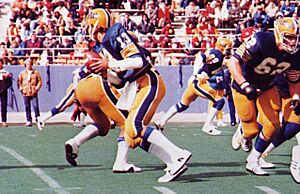
In the 1983 NFL Draft, the Jets chose quarterback Ken O'Brien. Many people later wondered if they should have picked Dan Marino, who became a star for the Dolphins and often beat the Jets. The Jets finished 7–9 in 1983. Their lease at Shea Stadium was ending, and after discussions, the team announced they would move to Giants Stadium in New Jersey for the 1984 season. Their last game at Shea was a 34–7 loss to the Steelers.
Early Years in New Jersey
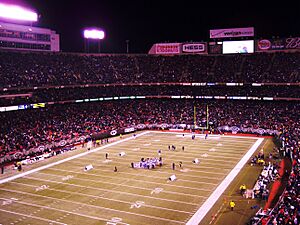
The Jets played their first regular season game at Giants Stadium on September 6, 1984, losing to the Steelers. They had another average season, finishing 7–9.
In 1985, the Jets made the playoffs with an 11–5 record, but they lost in the first round. In 1986, the Jets started incredibly well, winning 10 of their first 11 games, including a thrilling 51–45 overtime victory against the Dolphins where Ken O'Brien and Dan Marino threw for a combined 884 yards! However, injuries hit the team, and they lost their last five regular season games. They still made the playoffs and won their first game against the Kansas City Chiefs.
In the next playoff game against the Cleveland Browns, the Jets had a 20–10 lead. But a penalty on Mark Gastineau for hitting the quarterback late gave the Browns another chance. Cleveland tied the game and then won in double overtime, 23–20. Many Jets players felt they could have gone further that year.
In 1987, a player strike divided the team. The Jets finished 6–9. In 1988, the "Sack Exchange" era ended as key defensive players left or retired. Still, the Jets finished with an 8–7–1 record, even beating the Giants in the last game to keep their rivals out of the playoffs. But in 1989, the team had a very bad season, finishing 4–12. Coach Joe Walton was fired.
Looking for Success (1990–1996)
The Jets hired Bruce Coslet as their new head coach in 1990. They also drafted running back Blair Thomas, who was expected to be a star but struggled with injuries. Coslet's first season saw the Jets finish 6–10.
In 1991, the Jets improved and had a 7–8 record with one game left. They needed to beat the Miami Dolphins to make the playoffs, and they did, winning in overtime! In the wild card playoff game, the Jets lost a close one to Houston, 17–10.
The 1992 season was tough. Quarterback Browning Nagle became the starter, but the team lost its first four games. In November, defensive end Dennis Byrd suffered a serious neck injury during a game. His positive attitude inspired the team, and they went on to beat the Bills the next week. The Jets finished 4–12.
Before the 1993 season, the Jets got quarterback Boomer Esiason. They had another December collapse, losing four of their last five games to finish 8–8 and miss the playoffs. Coach Coslet was fired and replaced by defensive coordinator Pete Carroll.
Carroll's first season in 1994 started well. But in a key game against the Dolphins, the Jets had a big lead, only for Dan Marino to lead a famous comeback, faking a spike and throwing a winning touchdown pass. This loss started another December collapse, and the Jets didn't win again that season. Carroll was fired, and Rich Kotite became the new coach and general manager.
The Kotite era began with a huge 52–14 loss to the Dolphins in 1995. The team struggled, finishing 3–13. In 1996, the Jets brought in veteran quarterback Neil O'Donnell and drafted star wide receiver Keyshawn Johnson. But the team had its worst season ever, losing their first eight games and finishing 1–15. Kotite resigned, and a frustrated fan even threw a cup of beer at him after the last game.
Getting Back on Track (1997–2014)
The Bill Parcells Era
The Jets wanted to hire Bill Parcells, who had won two Super Bowls with the Giants. After some negotiations with the Patriots, where Parcells was coaching, the Jets finally hired him as head coach.
The Parcells era started with a big 41–3 win. The Jets improved a lot, finishing 9–6 in their first 15 games. They needed one more win to make the playoffs but lost their final game. Still, the team's improvement and Parcells' reputation created high hopes for 1998. The team also brought back a modified version of their classic 1960s uniforms.
Parcells signed star running back Curtis Martin and quarterback Vinny Testaverde. After a slow start, the Jets won six of their next seven games. They kept winning and clinched their first NFL division title since the merger in 1998, finishing with a franchise-record 12 wins and a first-round playoff bye.
The Jets beat the Jacksonville Jaguars 34–24 in their first home playoff game since 1986. This sent them to the AFC Championship Game against the Denver Broncos. The Jets had a 10–0 lead in the third quarter, but the Broncos, led by John Elway, came back and won 23–10.
In 1999, the Jets had high hopes, but quarterback Vinny Testaverde got injured in the first game and missed the season. The team finished 8–8. After the season, Parcells resigned as coach but stayed on as a team executive. Bill Belichick was supposed to take over as coach, but he resigned after just one day to go to the Patriots.
In 2000, Woody Johnson bought the team for $635 million. The Jets traded wide receiver Keyshawn Johnson and, with other draft picks, selected important players like quarterback Chad Pennington, defensive linemen John Abraham and Shaun Ellis, and tight end Anthony Becht. The Jets started the season by winning their first four games, including a famous "Monday Night Miracle" where they came back from a 30–7 deficit to beat the Dolphins 40–37 in overtime! They finished 9–7 but missed the playoffs.
The Herman Edwards Years
On January 18, 2001, the Jets hired Herman Edwards as their new coach. He was the first African-American head coach for the Jets. His first game was just two days before the September 11 attacks. After 9/11, the NFL decided to move that week's games to the end of the season. The Jets needed to win their final game against the Raiders to make the playoffs, and they did with a last-minute field goal! Edwards was the first coach to lead the Jets to the playoffs in his first year. They lost to the Raiders again in the playoffs.
The Jets started the 2002 season 1–4 but then won six games in a row. On the last day of the season, they beat the Packers, and with another team's help, they won their division title and made the playoffs! Chad Pennington had a great season and was the top-rated passer in the league. The Jets crushed the Indianapolis Colts 41–0 in the first playoff game but lost to the Raiders again in the next round.
In 2003, Pennington had a serious wrist injury and missed much of the season. The Jets finished 6–10. In 2004, with a healthy Pennington, the Jets started 5–0 for the first time! They made the playoffs again and won a thrilling overtime game against the San Diego Chargers. They then played the 15–1 Pittsburgh Steelers in the next round. The game went to overtime, but the Jets missed two field goals, and the Steelers won 20–17.
In 2005, both Pennington and his backup quarterback got injured. The Jets had a tough season, finishing 4–12.
Eric Mangini and Rex Ryan
In 2006, Herman Edwards left to coach the Kansas City Chiefs. The Jets hired Eric Mangini, a former Patriots defensive coordinator. Mangini led the Jets to a 10–6 record and a playoff spot in his first year! They lost to the Patriots in the wild card round. Mangini was nicknamed "Mangenius" for his success.
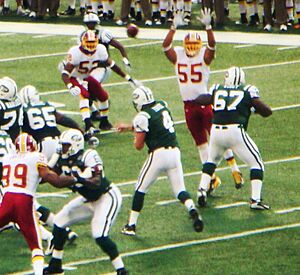
In 2007, the Jets accused the Patriots of secretly videotaping their signals, which led to fines for the Patriots. The Jets struggled that season, finishing 4–12. In 2008, the Jets made a big move by trading for legendary quarterback Brett Favre from the Green Bay Packers. Favre started well, but injuries hurt his performance late in the season. The Jets finished 9–7 and missed the playoffs after losing to the Dolphins in the final game. Mangini was fired after the season.
In 2009, the Jets hired Rex Ryan as their new head coach. They also drafted highly-rated quarterback Mark Sanchez. The Jets started 3–0 but then struggled before recovering to make the playoffs. They beat the Bengals in the last game ever at Giants Stadium to secure their playoff spot.
In the playoffs, the Jets beat the Bengals again, then upset the San Diego Chargers. This sent them to the AFC Championship Game against the Colts, where they lost 30–17.
The Jets moved into their new home, MetLife Stadium, in 2010. It's a huge stadium that can seat 82,500 fans. The Jets started the 2010 season well, but then had a big loss to the Patriots. Still, they made the playoffs as the last seed. They upset the Colts and then the Patriots in the playoffs, setting up another AFC Championship Game against the Pittsburgh Steelers. The Jets fell behind early and lost 24–19.
In 2011, Ryan promised a Super Bowl appearance, but the Jets finished 8–8 and missed the playoffs. In 2012, the Jets acquired quarterback Tim Tebow, which created a lot of discussion, but he wasn't used much. The Jets finished 6–10, their first losing season under Ryan. Ryan stayed as coach, but the general manager was fired.
In 2013, the Jets drafted quarterback Geno Smith. Sanchez was injured, so Smith became the starter. The Jets finished 8–8. Ryan's contract was extended. In 2014, the Jets finished 4–12. Both Ryan and the general manager were fired after the season.
Recent Years (2015–Present)
Todd Bowles and Adam Gase
In 2015, the Jets hired Mike Maccagnan as general manager and Todd Bowles as head coach. Quarterback Ryan Fitzpatrick led the team to a 10–6 record, but they lost their final game and missed the playoffs.
The 2016 season started with high hopes but ended with a 5–11 record due to injuries and inconsistent play. In 2017, the Jets finished 5–11 again. In 2018, rookie quarterback Sam Darnold showed some promise, but the team finished 4–12, and Bowles was fired.
In 2019, the Jets hired Adam Gase as head coach. They also signed some expensive players like Le'Veon Bell and C. J. Mosley. The team also introduced new uniforms that looked like their 1980s style. The Jets started 1–4 with Darnold out due to illness but finished the season 7–9.
The 2020 season was tough. Star safety Jamal Adams was traded, and Le'Veon Bell was released. The Jets had a franchise-worst 0–13 start before winning their first game. They finished 2–14, and Gase was fired.
Robert Saleh Era
On January 14, 2021, the Jets hired Robert Saleh as their new head coach. They also traded Sam Darnold and drafted quarterback Zach Wilson with the second overall pick in the 2021 NFL Draft. Wilson was inconsistent, and the Jets finished 4–13. They missed the playoffs for the 11th straight year, which was the longest streak in the NFL at the time. In 2022, the Jets improved to 7–10 but still missed the playoffs.
In April 2023, the Jets acquired Super Bowl-winning quarterback Aaron Rodgers from the Green Bay Packers. Rodgers, who was 39, predicted the Jets could win another Super Bowl. There was a lot of excitement for the 2023 season. However, in the very first game, Rodgers was injured without completing a pass, tearing his Achilles tendon and ending his season. Zach Wilson took over, and the Jets finished 7–10, missing the playoffs again. In April 2024, the Jets traded Zach Wilson to the Broncos.
The Jets have a special place in football history because of their Super Bowl III win. Even though they've only won one championship, that moment made them famous. Fans are always hoping for another great success to bring that excitement back!
See also
- List of New York Jets seasons


